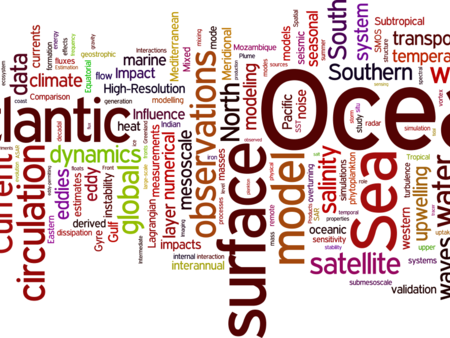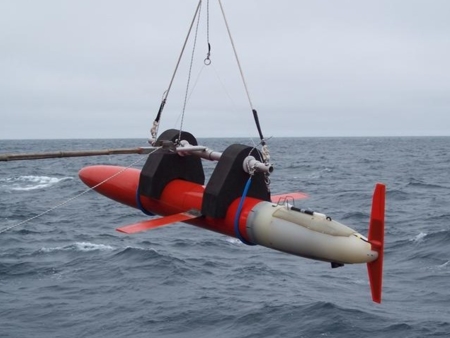Raphael Ravasse
Supervisors : X. Carton, J. Gula
Start date : October 2023
Summary
Oceanic eddies contribute significantly to global fluxes of heat, salt, carbon and biogeochemical tracers. Surface intensified mesoscale eddies, with radii larger than the Rossby deformation radius (30-200 km), have been studied extensively using altimetric observations. However, we know much less about the contribution of subsurface eddies, particularly submesoscale (1-30 km) subsurface eddies due to the sparsity of in situ observations.
Observations and high resolution models provide glimpses of the ocean interior richness and suggest that it is populated by a large number of deep submesoscale coherent vortices (SCVs). SCVs are long-lived energetic eddies, which can generate long-range anomalous transport of water properties and biogeochemical tracers.
However, a global census of the SCVs and their impact on the global circulation is still lacking. Furthermore, climate-scale ocean models do not resolve submesoscale motions, understanding and parameterizing these phenomena within models is critical for a better prediction of climate.
The aim of this project is to characterise SCV structure, properties and dynamics, using mathematical theory, a realistic submesoscale resolving simulation of the full Atlantic ocean, as well as in situ observations from moorings, gliders and Argo floats. The project will investigate in particular the processes responsible for the generation and destruction of SCVs in different regions of the Atlantic, their 3D structure, the interactions between SCVs and their environment, and try to answer a long standing question in oceanography: why are there more submesoscale anticyclones than cyclones in the interior ocean?
Submesoscale oceanic currents are density fronts and filaments, coherent vortices, and topographic wakes (McWilliams, 2016). They exist at scales below the first deformation radius (usually < 20km) ; among them, the submesoscale coherent vortices (SCVs) are ubiquitous in the oceans (see figure 1).
Figure 1:
Fig 1 : Relative vorticity [10 -4 s -1 ] over the isopycnal 27.8 in a 3-km Atlantic simulation [See here ]
SCVs can be very long-lived (> 1 year) and travel far away from their origin, advected by mesoscale and mean currents. As SCVs retain much of their core water mass during their life, they can generate long-range anomalous transport of water properties. The cumulative effect of SCVs can potentially affect the large scale transport and distribution of heat, nutrients and other materials. SCVs have been observed in most regions of the global ocean and in particular in the Atlantic ocean [Fig. 1]. Among SCVs are the Meddies (Bashmachnikov et al., 2015), and those of the West African upwelling (Pietri & Karstensen, 2018). These SCVs redistribute properties from the eastern boundary upwelling regions into the open ocean (Frenger et al., 2018). More generally SCVs can be generated by interaction of boundary currents with topography (Bower et al., 2013). SCV are also generated in the deep ocean, where the geostrophic currents interact with the Mid-Atlantic ridge, and play a rôle for the dispersion of biogeochemical materials (Vic et al., 2018).
The ocean interior is populated by a large number of deep SCVs(McCoy et al, 20), but unfortunately the ocean is still largely undersampled. On the other hand, global ocean models do not have a resolution sufficient to accurately represent SCVs . Furthermore, observations show a larger number of anticyclonic SCVs than cyclonic SCVs, but the reason why is still unknown (McWilliams, 16). We do not know if it is related to an asymmetry of the generation processes or to different stability properties of the SCVs.
Objectives
The aim of this project is to characterise the structure and dynamics of SCVs in the Atlantic Ocean using a mathematical theory, a realistic very high-resolution simulation of the full Atlantic ocean, which will be validated by comparisons with in situ observations from moorings and Argo floats. The objectives are also to identify the processes responsible for the generation and destruction of the SCVs, in particular to understand why we detect more submesoscale anticyclones than cyclones in the interior ocean, and finally to quantify their impact on the large scale circulation.
Data and methods
We will use the mathematical theory of fluids to precisely define the SCVs; then, this characterisation will be applied to high-resolution model simulations, as well as to available observations from moorings and Argo buoys. Realistic simulations of the Atlantic with the model CROCO are available with horizontal resolutions 6 km, 3 km, and 1 km (GIGATL: https://github.com/Mesharou/GIGATL). These simulations will be used in this project to describe the distribution of SCVs and to analyze their impact on the basin circulation. Higher resolution simulations (dx < 1 km) are available in various regions of the Atlantic to study the local impacts and generation processes. Increasing the resolution from 6-km to 1-km already provides a significant increase in the number and amplitude of SCVs [Fig. 2].
Figure 2: Relative vorticity [scaled by f] at 1000 m depth from 6-km and 1-km simulations
1.Structure and evolution of SCVs
We will first provide mathematical criteria for the structure of SCVs. After their detection in the numerical model results, we will determine their physical and dynamical characteristics and their spatial and temporal variability :propagation of these eddies, amplitude, radius, lifespan, propagation speed, propagation distance, preferred trajectories, formation and dead zones. We will also look at the ratio between cyclonic and anticyclonic SCVs in the different regions, and check how it varies depending on the SCVs age and origin. In particular we will check if the ratio matches the ratio of prograde versus retrograde currents, or if it is related to a different behavior for the cyclones and anticyclones after their generation. The Argo statistics and moorings data may be used to validate these results.
2. Generation mechanisms and life-cycle of SCVs
The previous statistics will provide knowledge on the preferred eddy formation and decay regions. Then, using targeted realistic and/or idealized numerical simulations, we aim to investigate: the generation mechanisms of SCVs in the different regions; the mechanisms driving SCVs trajectories (e.g. advection by mean currents, interactions with the mesoscale eddies); the interactions between SCVs (cyclonic and/or anticyclonic) possibly leading to erosion, fusion or alignment of SCVs; the mechanisms leading to SCVs destruction (e.g. large scale current shear and strain, interactions with topography); the mechanisms potentially leading to different stability properties for the cyclones and anticyclones.
3. Coherence, transport, and impact on the large scale circulation
Finally, we plan to assess the contribution of SCVs to the transport of waters and to the budget of temperature, salinity and energy in the Atlantic ocean. This will be performed using Lagrangian experiences to evaluate the coherence of the SCVs and the mass transport they induce. Different mathematical definitions for Lagrangian Coherent Structures might be compared (Haller, 15, Allshouse & Peacock, 15, Hadjighasem et al, 17, Denes et al, 22). This work will be a first step towards a rational representation of the SCV fluxes in coarser-resolution models where submesoscale dynamics are not resolved.







